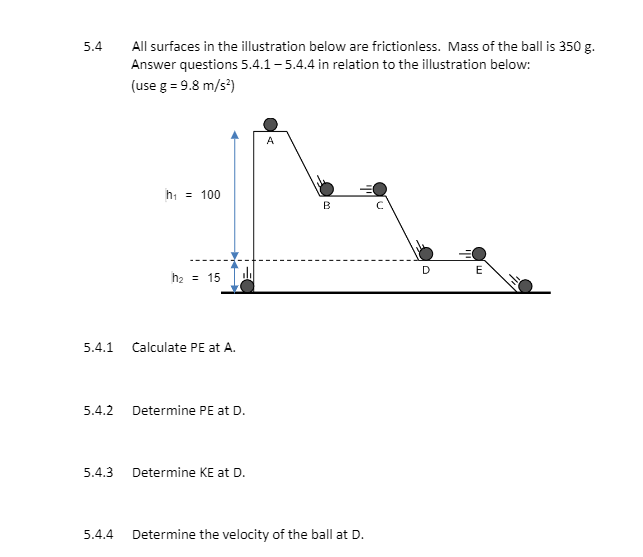All surfaces in the illustration below are frictionless. Mass of the ball is 350 g. Answer questions 5.4.1– 5.4.4 in relation to the illustration below: (use g = 9.8 m/s³) 5.4 h: = 100 D h2 = 15 5.4.1 Calculate PE at A. 5.4.2 Determine PE at D. 5.4.3 Determine KE at D. 5.4.4 Determine the velocity of the ball at D.
All surfaces in the illustration below are frictionless. Mass of the ball is 350 g. Answer questions 5.4.1– 5.4.4 in relation to the illustration below: (use g = 9.8 m/s³) 5.4 h: = 100 D h2 = 15 5.4.1 Calculate PE at A. 5.4.2 Determine PE at D. 5.4.3 Determine KE at D. 5.4.4 Determine the velocity of the ball at D.
Related questions
Question

Transcribed Image Text:5.4
All surfaces in the illustration below are frictionless. Mass of the ball is 350 g.
Answer questions 5.4.1- 5.4.4 in relation to the illustration below:
(use g = 9.8 m/s?)
A
h, = 100
B
D
h2 = 15
5.4.1
Calculate PE at A.
5.4.2
Determine PE at D.
5.4.3
Determine KE at D.
5.4.4
Determine the velocity of the ball at D.
Expert Solution
This question has been solved!
Explore an expertly crafted, step-by-step solution for a thorough understanding of key concepts.
This is a popular solution!
Trending now
This is a popular solution!
Step by step
Solved in 4 steps
